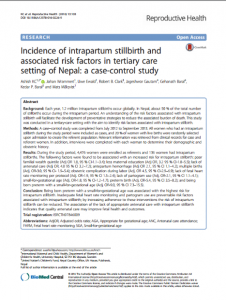
Background: Each year, 1.2 million intrapartum stillbirths occur globally. In Nepal, about 50% of the total number of stillbirths occur during the intrapartum period. An understanding of the risk factors associated with intrapartum stillbirth will facilitate the development of preventative strategies to reduce the burden of death. This study was conducted in a tertiary-care setting with the aim to identify the risk factors associated with intrapartum stillbirth.
Methods: A case-control study was completed from July 2012 to September 2013. All women who had an intrapartum stillbirth during the study period were included as cases, and 20% of women with live births were randomly selected on admission to make up the referent population. Information from the clinical records of case and referent women was retrieved. In addition, interviews were completed with each woman on their demographic and obstetric history.
Results: During the study period, 4,476 women with live births were enrolled as referents and 136 women with intrapartum stillbirths as cases. The following factors were found to increase the risk for intrapartum stillbirth: poor familial wealth quintile (Adj OR 1.8, 95% CI-1.1-3.4); less maternal education (Adj OR, 3.2 95% CI-1.8-5.5); lack of antenatal care (Adj OR, 4.8 95% CI 3.2-7.2); antepartum hemorrhage (Adj OR 2.1, 95% CI 1.1-4.2); multiple births (Adj. OR-3.0, 95% CI- 1.9-5.4); obstetric complication during the labor period (Adj. OR 4.5, 95% CI-2.9-6.9); lack of fetal heart rate monitoring per protocol (Adj. OR-1.9, 95% CI 1.5-2.4); no partogram use (Adj. OR-2.1, 95% CI 1.1-4.1); small weight for gestational age (Adj. OR-1.8, 95% CI-1.2-1.7); premature birth (Adj. OR-5.4, 95% CI 3.5-8.2); and being born premature and with small weight for gestational age (Adj. OR-9.0, 95% CI 7.3-15.5).
Conclusion: Fetal heart rate monitoring and partogram use are the effective interventions that can reduce the incidence of intrapartum stillbirth as each can detect obstetric complications during the intrapartum period. Preterm birth and small weight for gestational age were the factors that had the highest risk for intrapartum stillbirth, which indicates that adequate antenatal care can improve the health and growth of the baby and prevent premature death.